
Swainsona is a genus of about 85 species of flowering plants in the family Fabaceae, and is endemic to Australia. Plants in this genus are herbs or subshrubs with imparipinnate leaves and usually purple flowers similar to others in the family.

Swainsona galegifolia commonly known as smooth Darling pea, is a species of flowering plant in the family Fabaceae and is endemic to Australia. It is a small shrub with greyish-green leaves and flowers in white, red, pink, purple, yellow or orange.

Swainsona behriana, commonly known as Behr's swainsona, is a species of flowering plant in the family Fabaceae and is endemic to south-eastern continental Australia. It is a prostrate or low-growing perennial herb with imparipinnate leaves usually with 9 to 13 narrowly elliptic to egg-shaped leaflets with the narrower end towards the base, and racemes of 2 to 7 purple flowers.
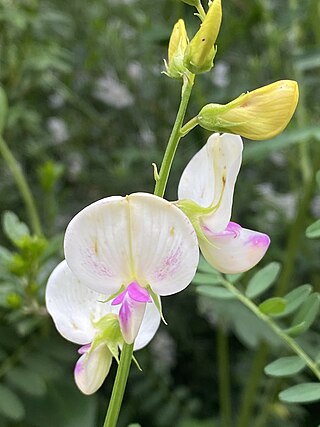
Swainsona sejuncta is a species of flowering plant in the family Fabaceae. It has pea-shaped flowers in a variety of colours, pink, cream, orange and mauve from spring to summer and is endemic to Queensland.

Goodenia holtzeana is a species of flowering plant in the family Goodeniaceae and is endemic to northern parts of the Northern Territory. It is a prostrate to ascending or erect annual plant with egg-shaped to lance-shaped stem-leaves with the narrower end towards the base, and racemes of yellow flowers with brownish markings.
Goodenia potamica is a species of flowering plant in the family Goodeniaceae and is endemic to the Northern Territory. It is a prostrate to ascending herb with elliptic to oblong leaves on the stems and racemes of yellow flowers.
Goodenia wilunensis is a species of flowering plant in the family Goodeniaceae and is endemic to central regions of Western Australia. It is an ascending to prostrate annual herb covered with silky hairs and has elliptic to egg-shaped leaves with the narrower end towards the base, and racemes of yellow flowers with purplish markings.
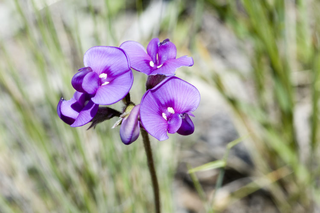
Swainsona sericea commonly known as silky Swainson-pea or silky pea, is a flowering plant in the family Fabaceae. It is a small perennial with greyish-green leaves, purple flowers and grows in New South Wales, Victoria and South Australia.
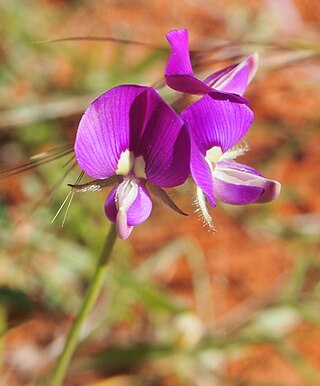
Swainsona phacoides commonly known as dwarf Swainson-pea or lilac Darling pea, is a flowering plant in the family Fabaceae. It is a small perennial herb, usually purple flowers and grows in all mainland states of Australia and the Northern Territory.

Swainsona swainsonioides commonly known as downy Swainson-pea or downy Darling pea,is a flowering plant in the family Fabaceae. It is a small perennial herb with purple flowers and grows in eastern states of Australia.
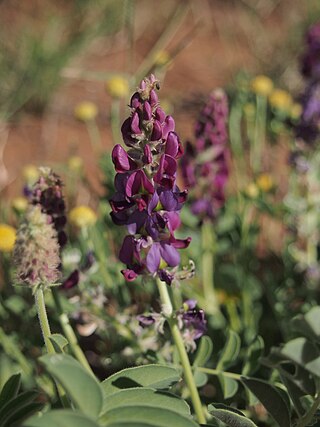
Swainsona canescens, commonly known as grey swainsona, is a flowering plant in the family Fabaceae. It is a small perennial herb with pink-purple or purple, yellow and green flowers and grows in Queensland, Western Australia and South Australia.
Swainsona acuticarinata is a species of flowering plant in the family Fabaceae and is endemic to arid areas of central Australia. It is a prostrate perennial herb with imparipinnate leaves with 5 to 11 leaflets, and racemes of purple flowers.
Swainsona adenophylla, commonly known as violet swainson-pea or violet Darling pea, is a species of flowering plant in the family Fabaceae and is endemic to arid areas of central Australia. It is a slender, erect or spreading perennial herb with imparipinnate leaves with three to nine linear to narrowly egg-shaped leaflets, and racemes of pink or purplish flowers in racemes of ten to twenty.
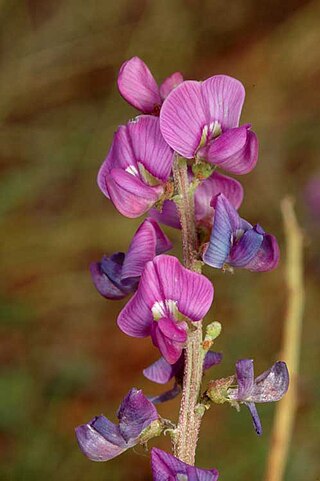
Swainsona affinis, commonly known as common poison pea, is a species of flowering plant in the family Fabaceae and is endemic to arid areas of inland Australia. It is a prostrate perennial herb with imparipinnate leaves with 7 to 25 broadly elliptic leaflets, and racemes of purple, pink, yellow or white flowers.

Swainsona beasleyana is a species of flowering plant in the family Fabaceae and is endemic to inland areas of Western Australia. It is a low-lying perennial herb with imparipinnate leaves usually with 15 to 19 egg-shaped leaflets with the narrower end towards the base, and racemes of 3 to 8 pale or dark purple flowers.

Swainsona brachycarpa, commonly known as slender swainson-pea, is a species of flowering plant in the family Fabaceae and is endemic to eastern Australia. It is a prostrate or ascending perennial herb with imparipinnate leaves usually with 9 to 13 egg-shaped to narrowly elliptic or egg-shaped leaflets, and racemes of up to 12 white, purple or dark red flowers.
Swainsona bracteata is a species of flowering plant in the family Fabaceae and is endemic to eastern Australia. It is a perennial herb with imparipinnate leaves usually with 19 to 25 narrowly egg-shaped leaflets, and racemes of about 20 white, pale pink or pale purple flowers.
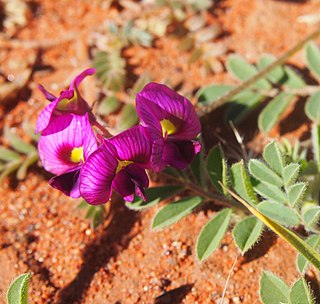
Swainsona burkei is a species of flowering plant in the family Fabaceae and is endemic to northern Australia. It is a prostrate or perennial subshrub with imparipinnate leaves usually with 5 to 11 oblong to narrowly egg-shaped leaflets, and racemes of 5 to 10 purple flowers.
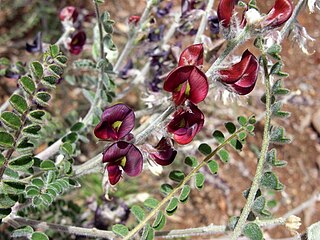
Swainsona burkittii, commonly known as woolly Darling pea, is a species of flowering plant in the family Fabaceae and is endemic to inland Australia. It is an erect or low-lying perennial with imparipinnate leaves usually with 15 to 30 egg-shaped to more or less circular leaflets, and racemes of up to fifty dark reddish-purple flowers.
Swainsona cadellii is a species of flowering plant in the family Fabaceae and is endemic to inland New South Wales. It is a shrubby perennial with imparipinnate leaves usually with 5 to 15 mostly narrowly egg-shaped leaflets, and racemes of 15 to 20 white, pink or purple flowers.













